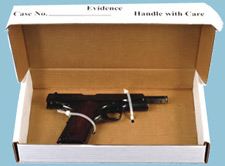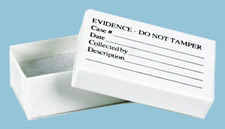Home | Glossary | Resources | Help | Contact Us | Course Map
Archival Notice
This is an archive page that is no longer being updated. It may contain outdated information and links may no longer function as originally intended.
At the Crime Scene
Safe handling of firearm evidence prior to arrival at the laboratory is critical. The on-site protocols used by investigators or crime scene technicians for the collection, packaging, and preservation of evidence items should address the potential dangers. These protocols must be followed whether the intention is to ship or hand-carry the evidence to the laboratory.
Firearms
Firearms collected during a crime scene search should be unloaded and made safe according to laboratory protocols. If there is any doubt as to the procedure for unloading a firearm and making it safe, assistance should be requested from a competent source (firearms instructor, departmental armorer, or an on-site firearm examiner). Unloaded ammunition should be packaged separately, marked, and identified as to the firearm from which it was removed.
Fired Bullets
Fired bullets are frequently found in two locations:
- At crime scenes, by crime scene technicians
- In bodies after shooting incidents, by medical examiners during autopsies
Fired bullets may bear bloodborne pathogens such as hepatitis or AIDS virus in blood, bone, and other tissues deposited on their surfaces after striking, passing through, or being recovered from shooting victims. Crime scene technicians, investigators, firearm examiners, and medical examiners should be very knowledgeable in the safe packaging and marking of fired bullets as potential biohazards.
Unfired Ammunition
Hand carrying unfired evidence ammunition to the laboratory is the safest and most convenient method of delivery. If the delivery to the laboratory requires the shipping of evidence, the United States Postal Service (USPS) will not ship unfired ammunition. Unfired ammunition must be shipped by private carriers such as United Parcel Service (UPS) and Federal Express (FedEx/Kinkos), among others. To comply with United States Department of Transportation (DOT) regulations, each private carrier has specific hazardous material packaging, labeling, and invoice requirements. Regardless of the fact that the shipper is a law enforcement agency or state or government-supported forensic laboratory, these requirements must be followed. It is the responsibility of the agency to ensure that evidence is shipped correctly, while complying with both the government and the shippers current safety regulations.
Additional Online Courses
- What Every First Responding Officer Should Know About DNA Evidence
- Collecting DNA Evidence at Property Crime Scenes
- DNA – A Prosecutor’s Practice Notebook
- Crime Scene and DNA Basics
- Laboratory Safety Programs
- DNA Amplification
- Population Genetics and Statistics
- Non-STR DNA Markers: SNPs, Y-STRs, LCN and mtDNA
- Firearms Examiner Training
- Forensic DNA Education for Law Enforcement Decisionmakers
- What Every Investigator and Evidence Technician Should Know About DNA Evidence
- Principles of Forensic DNA for Officers of the Court
- Law 101: Legal Guide for the Forensic Expert
- Laboratory Orientation and Testing of Body Fluids and Tissues
- DNA Extraction and Quantitation
- STR Data Analysis and Interpretation
- Communication Skills, Report Writing, and Courtroom Testimony
- Español for Law Enforcement
- Amplified DNA Product Separation for Forensic Analysts



